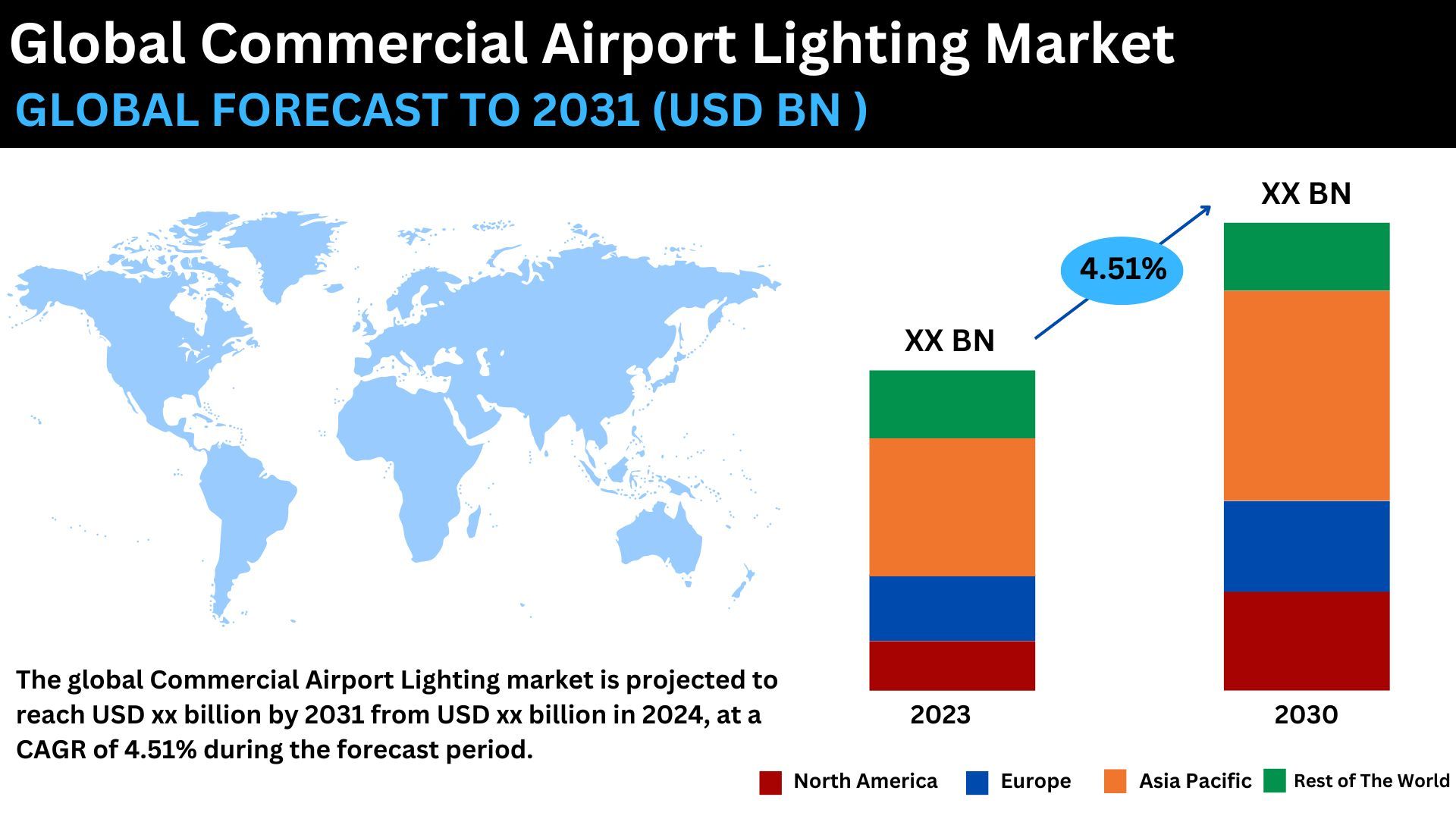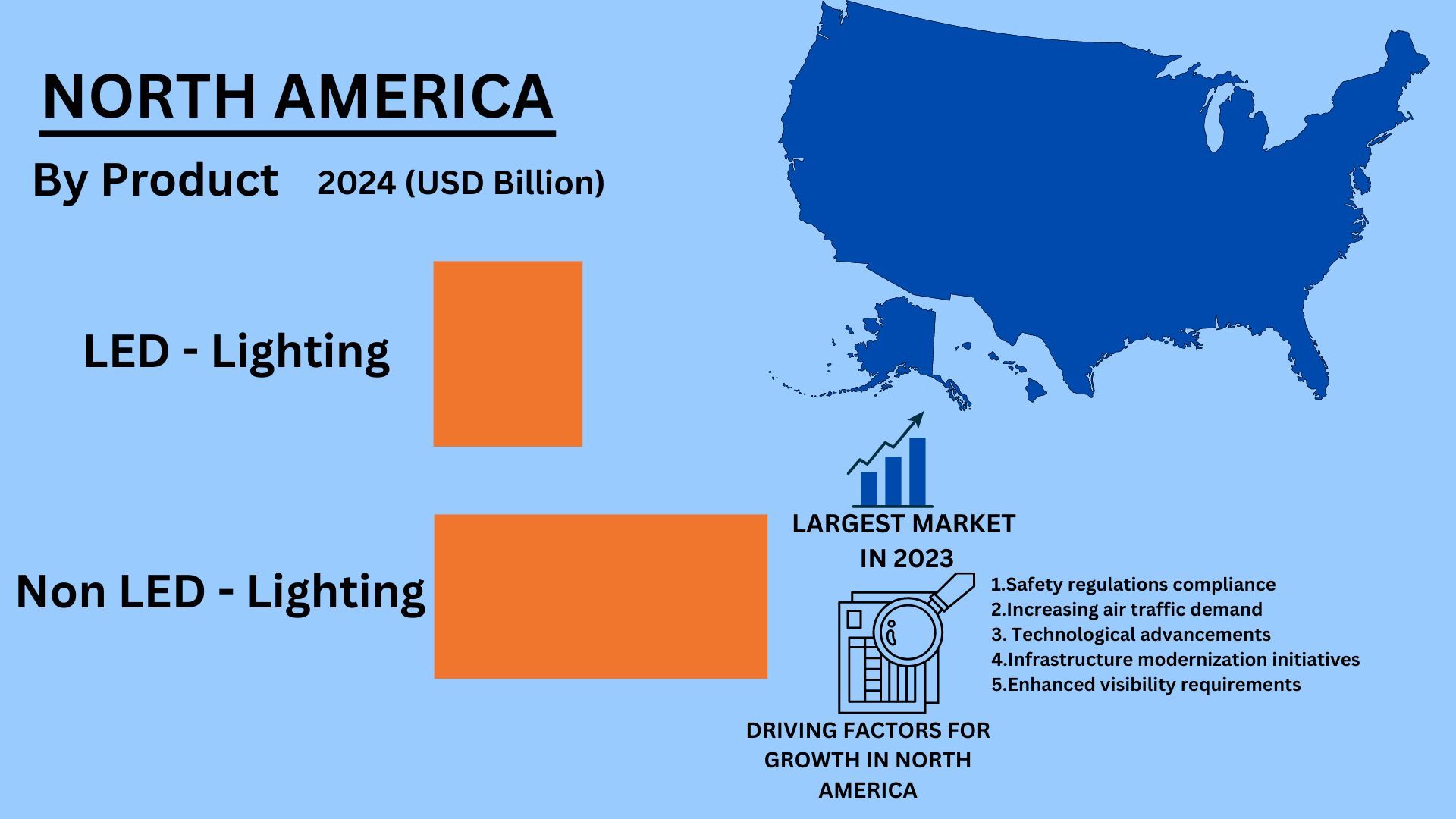Global Commercial Airport Lighting Market
EMI10104 ID | Aerospace & Defence | March-2024 | 233 PagesAccording to revenue estimates, the global commercial airport lighting market was valued USD XX billion in 2023. From 2024 to 2031, it is expected to increase at a compound annual growth rate (CAGR) of 4.51%.

The Commercial Airport Lighting Market is the sector of the economy that deals with the planning, production, installation, and maintenance of lighting systems at airports, mostly for commercial purposes. These lighting systems include approach lights, runway lights, taxiway lights, apn lights, and lighting for the terminal area, among other things. They are essential to ensuring the safety of aircraft operations, especially in low-light or nighttime conditions. The market involves a wide range of players, including manufacturers, suppliers, contractors, and airport authorities. Some of the drivers driving this market's growth include increased aircraft traffic, modernization and expansion of airports, rules mandating better safety standards, and technological advancements in lighting solutions. To ensure operating efficiency and safety, the commercial airport lighting industry stands out for its inventiveness, dependability, and adherence to strict industry standards.
Market Dynamics for Commercial Airport Lighting
Drivers: Global air traveler volume is driving the need for improved airport facilities.
Careful design and adherence to industry standards are necessary to ensure that lighting systems are compatible and interoperable with the current airport infrastructure. This entails carrying out exhaustive compatibility analyses, smoothly integrating new systems with the current infrastructure, and putting in place reliable communication protocols. In order to guarantee seamless integration and dependable operation, which will eventually improve safety and efficiency within the airport environment, cooperation between lighting system manufacturers, airport authorities, and regulatory agencies is essential.
Restraints: obstacles associated in integrating contemporary lighting technologies into older airport infrastructure.
There are several obstacles to overcome when retrofitting older airport infrastructure with contemporary lighting technologies. First of all, there might be problems with compatibility between new lighting systems and the current electrical infrastructure, necessitating expensive changes. Second, more modern, heavier lighting fixtures could not have the structural support they need in older buildings. Furthermore, it can be difficult to integrate contemporary lighting systems while preserving operational continuity, and doing so could need significant downtime that would affect airport operations. Finally, during the retrofitting process, regulatory compliance and safety criteria need to be properly taken into account and satisfied.
Opportunities: Opportunities for expansion arise when new airports are built or expanded in growing economies.
Significant development potential are presented by the expansion and building of new airports in emerging economies. These initiatives improve commerce, draw in investment, and increase tourism, all of which contribute to economic growth in addition to improving connectivity. Additionally, they support the development of nearby infrastructure and generate employment. The need for air travel is expanding due to trends in urbanization and globalization, which makes investments in airport infrastructure essential to maximizing the potential of emerging economies.
Challenges: ensuring that lighting solutions work with the current airport infrastructure and are compatible with it.
Ensuring compatibility and interoperability of lighting systems with existing airport infrastructure involves meticulous planning and integration. This includes assessing current infrastructure specifications, such as power supply capacities and communication protocols, to seamlessly incorporate new lighting technologies. Collaboration between lighting specialists and airport engineers is essential to address potential challenges and ensure smooth integration without disrupting operations. Rigorous testing and validation procedures further guarantee that the upgraded systems meet safety standards and function reliably within the airport environment.

Global Commercial Airport Lighting Market Ecosystem Well-known producers and service providers of commercial airport lighting are among the leading businesses in this industry. These businesses have been on the market for a while and have a strong worldwide sales and marketing network, as well as a broad product portfolio, organic and inorganic strategies. Several notable companies are Koninklijke Philips N.V., Eaton Corporation plc, Abacus Lighting Ltd., ADB Safegate BVBA, Airsafe Airport Equipment Co. Ltd., ATG Airports Ltd., Avlite Systems (Avlite Systems, part of SPX Corporation), TKH Airport Solutions B.V., Youyang Airport Lighting Equipment Inc., and Others.
Report Scope: Commercial Airport Lighting Market
| Report Metric | Details |
|---|---|
| Market Size (Years) | 2020–2031 |
| Base Year Considered | 2023 |
| Forecast Period | 2024–2031 |
| Forecast Units | Million/Billion (USD) |
| Segments Covered | By Product Type, Application, and Region |
| Geographies Covered | North America, Europe, Asia Pacific, and Rest of the World |
| Companies Covered | Abacus Lighting Ltd, ADB Safegate BVBA, Airsafe Airport Equipment Co. Ltd, ATG Airports Ltd, Avlite Systems (Avlite Systems, part of SPX Corporation), Eaton Corporation plc, Koninklijke Philips N.V, TKH Airport Solutions B.V., Youyang Airport Lighting Equipment Inc., and Others |
